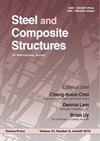Effect of web hole spacing on axial capacity of back-to-back cold-formed steel channels with edge-stiffened holes
IF 3.9
3区 工程技术
Q1 CONSTRUCTION & BUILDING TECHNOLOGY
引用次数: 24
Abstract
Recently, a new generation of cold-formed steel (CFS) channel section with edge-stiffened web holes has been developed by industry in New Zealand. However, no research has been reported in the literature to investigate the axial capacity of back-to-back channels with edge-stiffened web holes. This paper presents a total of 73 new results comprising 29 compression tests and 44 finite element analyses (FEA) on axial capacity of such back-to-back CFS channels. The results show that for back-to-back channels with seven edge-stiffened holes, the axial capacity increased by 19.2%, compared to plain channels without web holes. A non-linear finite element (FE) model was developed and validated against the test results. The validated FE model was used to conduct a parametric study involving 44 FE models. Finely, the tests results were compared with the design strengths calculated from the AISI and AS/NZ standards and from the proposed design equations of Moen and Schafer. From the comparison results, it was found that the AISI and AS/NZ design strengths are only 9% conservative to the test results for plain channels without web holes. While Moen and Schafer equations are conservative by 13% and 47% for axial capacity of CFS back-to-back channels with un-stiffened and edge-stiffened web holes, respectively.腹板孔间距对带边加劲孔的背靠背冷弯型钢通道轴向承载力的影响
最近,新西兰工业界开发了新一代冷弯型钢带边筋腹板孔道段。然而,没有研究报告在文献中调查背靠背通道的轴向能力与边加劲腹板孔。本文提出了73个新的结果,包括29个压缩试验和44个有限元分析(FEA),对这种背靠背的CFS通道的轴向能力。结果表明:与不带腹板孔的普通通道相比,带7个边加筋孔的背对背通道的轴向承载力提高了19.2%;建立了非线性有限元模型,并对试验结果进行了验证。采用验证的有限元模型对44个有限元模型进行参数化研究。最后,将试验结果与AISI和AS/NZ标准计算的设计强度以及Moen和Schafer提出的设计方程进行了比较。对比结果发现,对于无腹板孔的普通通道,AISI和AS/NZ设计强度与测试结果相比仅保守9%。而对于不加筋和边加筋的CFS背对背通道的轴向承载力,Moen和Schafer方程分别保守13%和47%。
本文章由计算机程序翻译,如有差异,请以英文原文为准。
求助全文
约1分钟内获得全文
求助全文
来源期刊

Steel and Composite Structures
工程技术-材料科学:复合
CiteScore
8.50
自引率
19.60%
发文量
0
审稿时长
7.5 months
期刊介绍:
Steel & Composite Structures, An International Journal, provides and excellent publication channel which reports the up-to-date research developments in the steel structures and steel-concrete composite structures, and FRP plated structures from the international steel community. The research results reported in this journal address all the aspects of theoretical and experimental research, including Buckling/Stability, Fatigue/Fracture, Fire Performance, Connections, Frames/Bridges, Plates/Shells, Composite Structural Components, Hybrid Structures, Fabrication/Maintenance, Design Codes, Dynamics/Vibrations, Nonferrous Metal Structures, Non-metalic plates, Analytical Methods.
The Journal specially wishes to bridge the gap between the theoretical developments and practical applications for the benefits of both academic researchers and practicing engineers. In this light, contributions from the practicing engineers are especially welcome.
 求助内容:
求助内容: 应助结果提醒方式:
应助结果提醒方式:


